Translate this page into:
An observational study on glabellar wrinkle patterns in Indians
2 Cosmetic Dermatology, Kamat Nursing Home, Ponda, Goa; Medicine, K.S. Hegde Medical Academy, Mangalore, Karnataka, India
Correspondence Address:
Amala Kamat
Kamat Nursing Home, Sapana Plaza, Alto Mount, Margao - 403 601, Goa
India
| How to cite this article: Kamat A, Quadros T. An observational study on glabellar wrinkle patterns in Indians. Indian J Dermatol Venereol Leprol 2019;85:182-189 |
Abstract
Background: Botulinum A exotoxin is an established treatment for glabellar frown lines, crow's feet, and horizontal furrows of the forehead. The glabella is probably the most common site for botulinum toxin treatment in Asians. Five glabellar contraction patterns have been classified in earlier studies based on eyebrow approximation, depression, and elevation. Unfortunately, this was found to be confusing by many practitioners. Indians, as all Asians, have smaller muscles compared to the European population, and there is no consensus on the optimal dosage per injection site or concentration of toxin to be used.
Aims: (a) Identification and classification of glabellar wrinkle patterns in Indians. (b) Optimization of the minimal effective dose of toxin per site.
Materials and Methods: Retrospective photographic analysis of 200 patients who received botulinum toxin for the first time to treat glabellar wrinkles was conducted. The wrinkle patterns were identified and classified by the authors based on the prevalence of perpendicular and transverse glabellar lines, nasal, and forehead wrinkles.
Results: Six patterns were identified: (1) 11 (2) U (3) Pi (4) X (5) W (6) I. The relevant muscles were identified and doses optimized for those sites.
Limitations: The doses mentioned in this study are not universal for all patients and toxin units would have to be altered and individualized according to the bulk of the facial muscles and individual needs.
Conclusion: The investigators classification, injection patterns, and dosage may provide valuable guidance to facial esthetic treatment.
Introduction
Glabella is the smooth midline elevation between the two eyebrows. It easily attracts the attention of patients and their observers as it occupies a relatively central location on the face.[1] Contraction of the forehead muscles can lead to the formation of wrinkles that may range from fine lines to deep furrows and often express varied emotions such as annoyance, exhaustion, fear, worry, or anger.
As an individual ages, the glabellar wrinkle lines along with other facial folds remain noticeable and ingrained on the face not only when the individual is expressing an emotion but even when he is in repose.[2],[3]
Vertical glabellar folds are produced by the action of the corrugators, while horizontal glabellar lines appear due to the activity of the procerus. Other muscles like the orbicularis oculi pars palpebralis, depressor supercili, frontalis and nasalis are also involved in the formation of glabellar wrinkles.[4],[5]
In 2012, Almeida et al. described five types of glabellar contraction patterns: “U,” “V,” “Omega,” “Inverted omega,” and “Converging arrows”.[6],[7] These were not clinical patterns and were more dependent on eyebrow movements like raising, lowering, and approximation.
In 2014, Kim et al. described five wrinkle patterns in the Koreans: “U,” “'11,” “X,” “Pi,” and “I.” These were clinical representations of final wrinkle shapes determined by transverse and perpendicular glabellar lines as well as forehead and nasal wrinkles.[8] We found the Korean impressions easy to follow and compatible for our patients. As Indians have smaller muscles, the requirement of botulinum A toxin is lesser than Caucasian individuals and moreover, is not the same in men and women.[2],[3],[9],[10],[11]
We found six wrinkle patterns – “'11,” “U,” “Pi,” “X,” “W,” and a rare “I” in addition to a few combination patterns. The W/Trident pattern has not been described earlier.
Objective
The purpose of our study is to help select the correct muscles for injection of the botulinum toxin in Indians, as well as to optimize the units of toxin required, to decrease the appearance of glabellar lines that suggest negative emotions like anger and irritation, but still allow an adequate degree of emotional expressivity.
The patterns defined in all the studies done so far cater mostly to the western population and as Indians have smaller muscles in comparison, we aimed to find a consensus on the optimal dosage per injection site.
The study ultimately aims to not inject excessive toxin in unnecessary sites.
Materials and Methods
This is a retrospective observational case study done at Kamat Nursing Home, Madgaon, Goa, consisting of 200 randomly selected Indian patients; 70 males and 130 females; who had not undergone any cosmetic treatment in the preceding 6 months. Informed consent was obtained from all participants prior to the study.
The patients' age ranged from 21 to 80 years old. Patients with history of peels, microdermabrasion, fillers, and botulinum toxin in the past 6 months were not included in the analysis.
There was no restriction in gender or phenotype. The photos were taken at rest and during movement of the glabella in the same clinical settings.
Four members set up this classification pattern according to the wrinkle patterns observed in patients. This group consists of two dermatologists, an occuloplastic surgeon, and a medical clinical assistant. The study was presented at a clinical meeting with around 40 dermatologists, where the panel validated an Indian consensus recommendation on botulinum toxin treatment for the individual wrinkle patterns. A strong consensus was defined as approval from majority of the board members.
Results
Through our study of 200 Indian patients, we found six main wrinkle patterns –”11” pattern, “U” pattern, “X” pattern, “Pi” pattern, “W” pattern, and a rare 'I' pattern. We also found some combination patterns in a few of our patients [Pie Chart 1].

11 pattern
This pattern is the most common, and accounted for 80 (40%) cases in our study [Figure - 1] and [Figure - 2]. Patients with this pattern showed perpendicular glabellar lines across the forehead. The main muscles involved are the corrugators. Variants resembled “1” as a single line or as multiple lines across the eyebrows [Figure - 3], [Figure - 4], [Figure - 5], [Figure - 6]. Participants with this pattern can be injected at 2 points; 2 units into each of the corrugators, with a total dose of 4 units. In severe cases [Figure - 7] and [Figure - 8], a 4-point injection into the corrugators; 2 at each site with a total of 8 units was found effective.
 |
| Figure 1: Patient 1 - 11 Pattern |
 |
| Figure 2: Patient 1 - 11 Pattern - edited |
 |
| Figure 3: Patient 2 - 1 Pattern (mild) |
 |
| Figure 4: Patient 2 - 1 Pattern (mild) – edited |
 |
| Figure 5: Patient 3 - 1 Pattern (severe) |
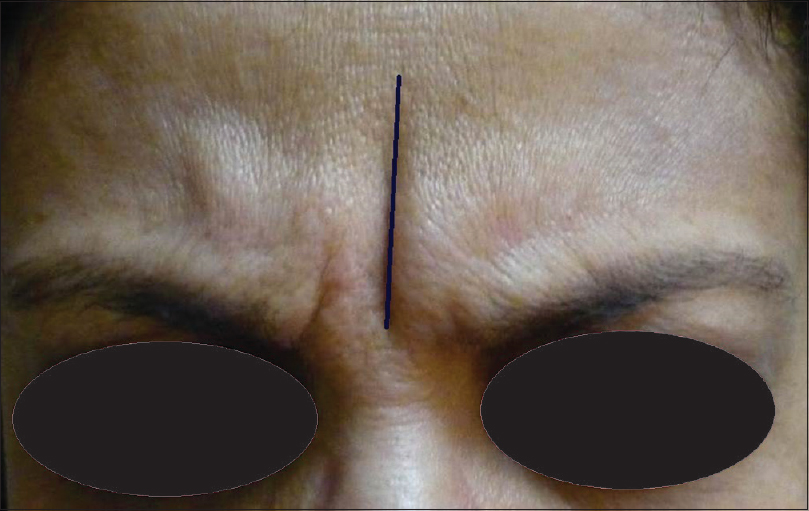 |
| Figure 6: Patient 3 - 1 Pattern (severe) – edited |
 |
| Figure 7: Patient 4 - 11 Pattern (severe) |
 |
| Figure 8: Patient 4 - 11 Pattern (severe) – edited |
U pattern
This is the second most common pattern among the patients in our study [Figure - 9], [Figure - 10], [Figure - 11], [Figure - 12], [Figure - 13], [Figure - 14]. It accounted for 60 (30%) cases. The patients classified in this pattern show both perpendicular and transverse glabellar lines formed by corrugators and the procerus forming a “U” shape. Participants with this pattern can be injected at 3 points; 2 units into each of the corrugators and 4 units in procerus, with a total dose of 8 units. In severe cases, a 5-point injection is advised; 2 units into 2 sites in each of the corrugators, and 4 units in the procerus, with a total of 12 units.
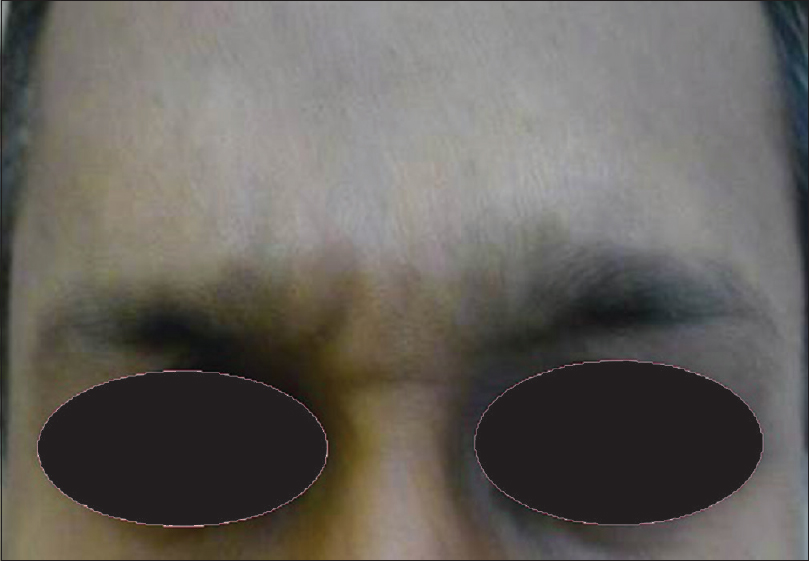 |
| Figure 9: Patient 5 – U Pattern (mild) |
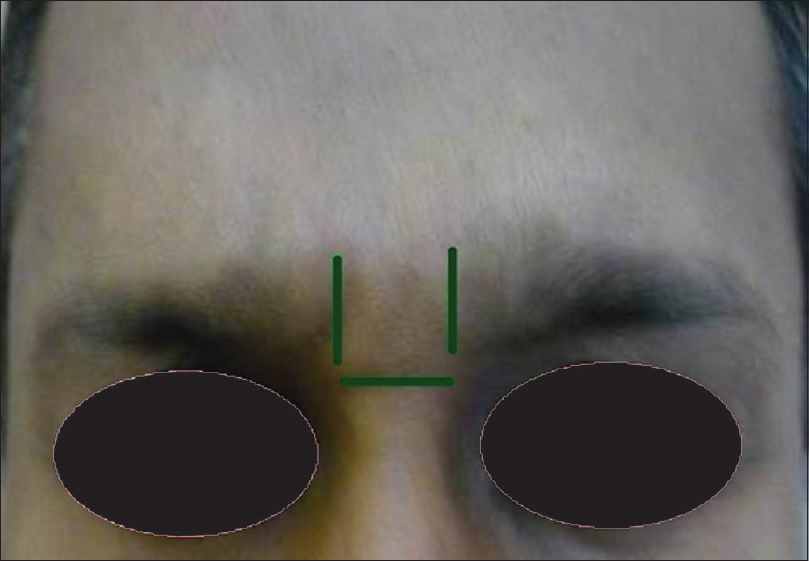 |
| Figure 10: Patient 5 - U Pattern (mild) – edited |
 |
| Figure 11: Patient 6 - U Pattern (moderate) |
 |
| Figure 12: Patient 6 - U Pattern (moderate) – edited |
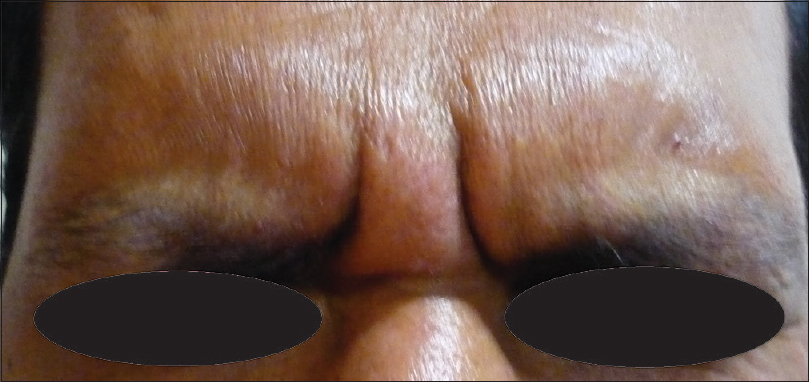 |
| Figure 13: Patient 7 - U Pattern (severe) |
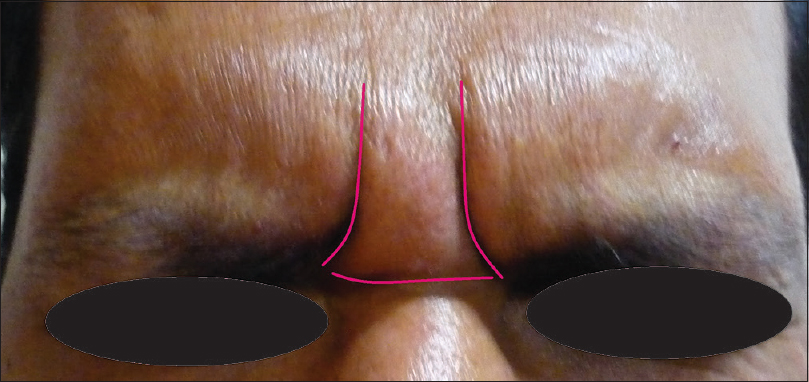 |
| Figure 14: Patient 7 - U Pattern (severe) – edited |
Pi pattern/omega pattern
This pattern accounted for 30 (15%) cases in our study [Figure - 15], [Figure - 16], [Figure - 17], [Figure - 18]. Patients with this pattern showed perpendicular glabellar lines along with forehead wrinkles, forming a pattern such as “Pi” or “Omega.” The main muscles involved are corrugators, medial part of orbicularis, and frontalis. Patients with this pattern can be injected at 5 points; 2 units at 3 sites into the frontalis, and 2 units into each corrugator, with a total dosage of 10 units.
 |
| Figure 15: Patient 8 – Pi Pattern (mild) |
 |
| Figure 16: Patient 8 - Pi Pattern (mild) – edited |
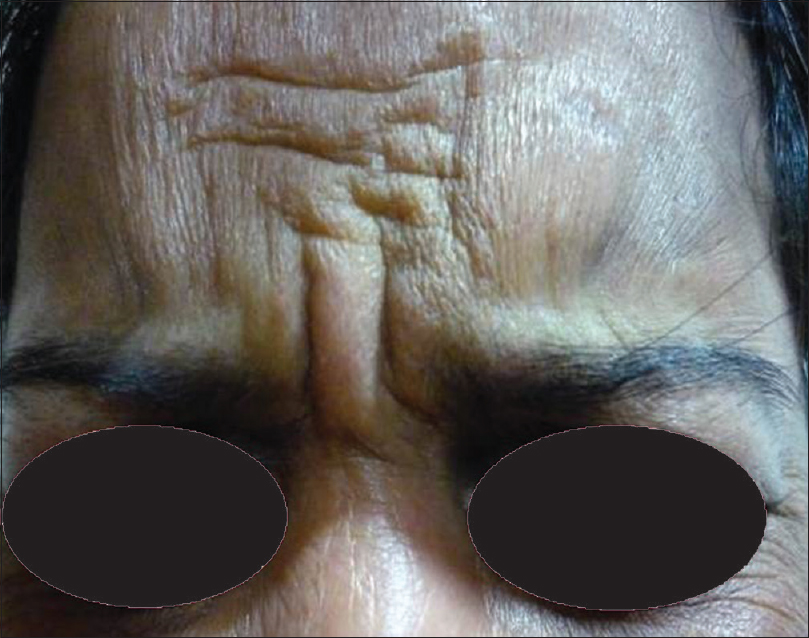 |
| Figure 17: Patient 9 - Pi Pattern (Severe) |
 |
| Figure 18: Patient 9 - Pi Pattern (Severe) – edited |
X pattern
This pattern was seen in 21 (10.5%) cases and is formed due to nasal wrinkles and both perpendicular and transverse glabellar lines [Figure - 19], [Figure - 20], [Figure - 21], [Figure - 22]. In this group of patients, the main muscles involved are the procerus and depressor supercilli. Internal portion of the orbicularis oculi, the corrugators, and the nasalis are also involved but to a lesser degree. Patients with this pattern can be injected at 5 points with the total dose of 10–12 units. They should be injected with 4 units in the procerus, 2 units in each nasalis, and 1–2 units into each corrugator.
 |
| Figure 19: Patient 10 - X Pattern (mild) |
 |
| Figure 20: Patient 10 - X Pattern (mild) – edited |
 |
| Figure 21: Patient 11 - X Pattern (moderate) |
 |
| Figure 22: Patient 11 - X Pattern (moderate) – edited |
W pattern/trident pattern
This pattern is rare and seen in only 3 (1.5%) of our patients [Figure - 23] and [Figure - 24]. Muscles involved in the formation of this pattern are bulky corrugators, procerus and frontalis. This pattern has not been described earlier in other studies, but we found it in some of our patients, however uncommon. This group needed to be injected with 3–4 units in the corrugators, 4 units in the procerus, and 2 units into 3 sites on each side of the frontalis, with a total dose of 16–18 units.
 |
| Figure 23: Patient 12 - W Pattern |
 |
| Figure 24: Patient 12 - W Pattern – edited |
I pattern
This is the most uncommon pattern of all and is formed by both perpendicular and transverse wrinkles [Figure - 25] and [Figure - 26]. Seen in only 2 (1%) of our patients. Muscles involved are the corrugators, procerus and the frontalis. These patients will benefit from injecting 4 units into the procerus, 2 units into corrugators, and one unit into frontalis, with a total dosage of 9 units.
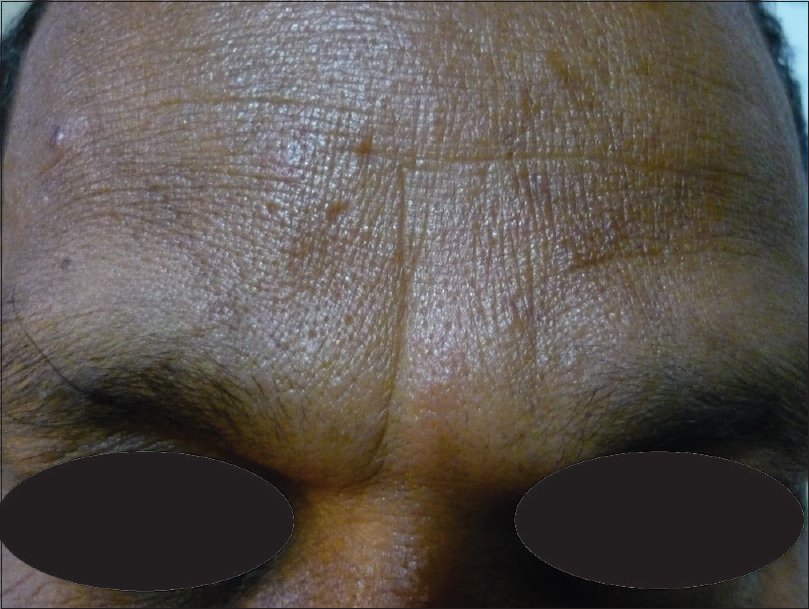 |
| Figure 25: Patient 13 – I Pattern |
 |
| Figure 26: Patient 13 – I Pattern - edited |
Combination patterns
There can sometimes be a combination of 2 wrinkle patterns in some patients and we saw 4 (2%) patients with such combination patterns. For example, we observed a combination of Pi and U pattern in one of our participants [Figure - 27] and [Figure - 28]. Here, in addition to the perpendicular and transverse lines formed by the corrugators and procerus (forming the U pattern), there is a horizontal line on the top formed by the frontalis. This patient needed to be injected at 6 points; 2 units into each of the corrugators, 4 units into the procerus and 2 units at 3 sites into the frontalis, with a total dosage of 14 units.
 |
| Figure 27: Patient 14 – Combination Pattern (Pi and U) |
 |
| Figure 28: Patient 14 – Combination Pattern (Pi and U) – edited |
Discussion
The most noticeable signs of facial aging begin to appear as glabellar rhytids. These changes become more pronounced as aging continues, and glabellar lines, along with other facial wrinkles and folds, remain unmistakable.[1] This makes the glabella the most popular site for botulinum toxin injection.
Diversity in glabellar wrinkle patterns have been observed and classified by Almeida et al. and Kim et al.; however, we felt that these classifications and the dosages would not be suitable for Indian patients due to smaller facial muscles.[7],[8] To overcome this problem, we have set up a classification with the approximate dosage of botulinum injection into each area of the forehead. In our study, we found 6 main wrinkle patterns – “11” pattern, “U” pattern, “X” pattern, “Pi” pattern and a rare “W” and “I” pattern. Overall, the “11” pattern was most common, followed by “U,” “X,” and “Pi” patterns. In few patients, we also found the rare “W/Trident” and “I” patterns. From the findings, we could postulate that the glabellar wrinkles mostly start with the sole presentation of the perpendicular lines of the glabellar (11 pattern) with the gradual involvement of the procerus (U pattern) and frontalis (Pi and I) as one ages or as the wrinkles become deeper.[2] The X pattern, however, is not age related.
To achieve satisfactory results in glabellar wrinkles with botulinum toxin, it is necessary to understand that, even among individuals with similar anatomical features, use of their musculature may vary. The classification of the glabellar wrinkle patterns facilitates the dose to be concentrated in the involved muscles and sparing those less used. We hope the consensus recommendation will help ensure treatment safety and efficacy in Indians, but should be further adapted in clinical practice to meet individual needs such as wrinkle asymmetry. We found our doses of botulinum toxin A adequate in our patients. This is not to say that this is sufficient or long lasting in all patients and the doses would have to be individualized.
Capsule summary
- Studies done on glabellar rhytids, have shown 5 patterns based on eyebrow movements, with doses of botulinum A toxin pertaining to the western population
- We identified 6 glabellar wrinkle patterns in Indians and suggested minimal effective dosage of toxin per site
- Selected the correct muscles for injection of toxin in Indians, and optimized units required.
Declaration of patient consent
The authors certify that they have obtained all appropriate patient consent forms. In the form, the patient has given his consent for his images and other clinical information to be reported in the journal. The patient understand that name and initials will not be published and due efforts will be made to conceal identity, but anonymity cannot be guaranteed.
Financial support and sponsorship
Nil.
Conflicts of interest
There are no conflicts of interest.
| 1. |
Cox SE, Finn JC. Social implications of hyperdynamic facial lines and patient satisfaction outcomes. Int Ophthalmol Clin 2005;45:13-24.
[Google Scholar]
|
| 2. |
Shirakabe Y, Suzuki Y, Lam SM. A new paradigm for the aging Asian face. Aesthetic Plast Surg 2003;27:397-402.
[Google Scholar]
|
| 3. |
Zhuang Z, Landsittel D, Benson S, Roberge R, Shaffer R. Facial anthropometric differences among gender, ethnicity, and age groups. Ann Occup Hyg 2010;54:391-402.
[Google Scholar]
|
| 4. |
Kane MA. Commentary: Asian consensus recommendations on the aesthetic usage of botulinum toxin type A. Dermatol Surg 2013;39:1861-7.
[Google Scholar]
|
| 5. |
Wen JH, Ji ZL, Lu F. Clinical anatomical study of the corrugators and procerus muscles. Chin J Aesthetic Plast Surg 2001;12: 42-45.
[Google Scholar]
|
| 6. |
de Almeida AR, da Costa Marques ER, Banegas R, Kadunc BV. Glabellar contraction patterns: A tool to optimize botulinum toxin treatment. Dermatol Surg 2012;38:1506-15.
[Google Scholar]
|
| 7. |
Trindade de Almeida AR, da Costa Marques ER, Kadunc BV. Glabellar wrinkles: A pilot study of contraction patterns. Surg Cosmet Dermatol 2010;2:23-28.
[Google Scholar]
|
| 8. |
Kim HS, Kim C, Cho H, Hwang JY, Kim YS. A study on glabellar wrinkle patterns in Koreans. J Eur Acad Dermatol Venereol 2014;28:1332-9.
[Google Scholar]
|
| 9. |
Hexsel C, Hexsel D, Porto MD, Schilling J, Siega C. Botulinum toxin type A for aging face and aesthetic uses. Dermatol Ther 2011;24:54-61.
[Google Scholar]
|
| 10. |
Carruthers JD, Glogau RG, Blitzer A; Facial Aesthetics Consensus Group Faculty. Advances in facial rejuvenation: Botulinum toxin type a, hyaluronic acid dermal fillers, and combination therapies – Consensus recommendations. Plast Reconstr Surg 2008;121:5S-30S.
[Google Scholar]
|
| 11. |
Rawlings AV. Ethnic skin types: Are there differences in skin structure and function? Int J Cosmet Sci 2006;28:79-93.
[Google Scholar]
|
Fulltext Views
8,620
PDF downloads
2,901





